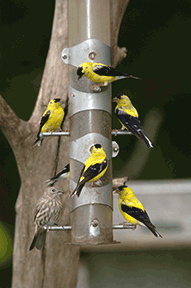Bird Feeder Maintenance

Many of us love to encourage birds to our gardens. One of the best ways of doing this is to provide a vast assortment of native plants. Of course, many of us supplement this with bird feeders. We get excited to fill the feeders and watch out feathered friends visit them, but we often neglect the most important thing, to keep your bird feeders clean to avoid the spread of disease.
Mycoplasmal conjunctivitis Biologists have noticed birds called house finches with swollen, crusty eyes and are concerned about a disease called house-finch eye disease, also called mycoplasmal conjunctivitis. This disease is slowly spreading across the U.S
Avian pox is a viral skin infection that shows up as warty growths on the head (particularly next to the eyes and beak), legs, wings or other body parts of the infected bird. Avian pox virus spreads between birds by biting insects, by direct bird-to-bird contact, and by indirect contact via contaminated surfaces such as perches or bird feeders. The virus is relatively resistant and can persist on contaminated surfaces for long periods of time.
Salmonellosis is a bacterial infection, which is present at a low level in wild bird populations. Salmonella outbreaks can be seen in wild birds typically during the winter months. Flocking ground feeders, such as finches and house sparrows, are most commonly affected.
Aspergillosis fungus (mold) grows on damp feed and in the debris beneath feeders. Birds inhale the fungal spores and the fungus spreads through their lungs and air sacs, causing bronchitis and pneumonia.
New Disease to watch our for
Trichomonas gallinae (canker) affects bird's digestive system. It typically affects finches, and doves and pigeons. It can also affect birds of prey that feed on pigeons and doves that are infected with the parasite. Any bird can catch the infection, but being bird specific, it does not pass on to mammals, including humans. So far the disease is causing problems in the UK, however it has spread to Canada's Atlantic Provinces where it has killed purple finches and goldfinches. It won't be long until it spreads to the US.
How to clean your feeder
Once a few weeks, take down your feeders to clean them, more often if you suspect there are any diseases spreading.
Scrub thoroughly to remove debris
Rinse well with soapy water
Soak them in a bucket of bleach solution ( nine-to-one water-bleach solution will deter bacteria in plastic, ceramic, and metal feeders. A dilute vinegar solution (three-to-one) or non-fragranced biodegradable soap should be used on wood to minimize fading.
rinse them
Air dry
Other ways to help reduce the spread of disease
Keep the area around feeders clean by sweeping spilled food and droppings. On snow-covered lawns, scraping off a few layers of snow should do the trick.
Spread your feeders out in different parts of your property. Crowding only expedites the spread of disease (Audubon Guide)
Only put out the amount of seed that can be eaten in a couple of days.
Store your bird feed away from any rodent visitors.
Provide safe feeders without sharp points or edges. Even small scratches and cuts will allow bacteria and viruses to enter otherwise healthy birds.
Project Feederwatch
Project Feederwatch is a great source for all things to do with feeders, bird species, and more. You can also sign up to be a citizen scientist through their feederwatch program by identifying the birds that visit your feeder. See https://feederwatch.org/

















